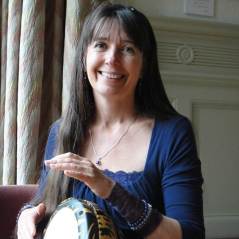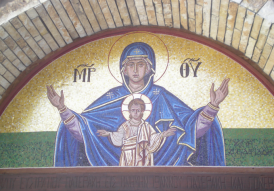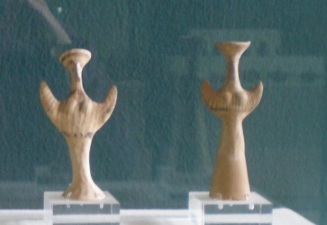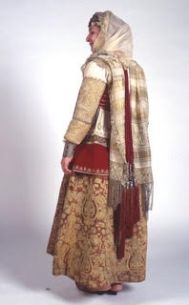 Western Easter has come and gone, and I missed it this year, by design. I went to Athens for the weekend, where Easter this year won’t come until May 1. In the Greek Orthodox Church, Easter is reckoned differently, so that sometimes (like next year) Easter falls on the same date in both faiths and sometimes (like now) the celebrations are several weeks apart.
Western Easter has come and gone, and I missed it this year, by design. I went to Athens for the weekend, where Easter this year won’t come until May 1. In the Greek Orthodox Church, Easter is reckoned differently, so that sometimes (like next year) Easter falls on the same date in both faiths and sometimes (like now) the celebrations are several weeks apart.
In contrast to the UK, where Easter now seems to be mostly about chocolate, Easter in Greece is the main festival of the Christian year, much more important than Christmas. Throughout the Lenten period, fasting foods – ‘nistisimo’ – are available everywhere (heaven for vegan visitors).
And many Greek Easter customs intertwine Christian and pre-Christian beliefs, revealing the changing layers of belief and custom here throughout history.
On Friday we attended the Chairetismoi (‘Rejoicings’) in the tiny candlelit church of the Holy Sepulchre in Plaka, where a group of male cantors with beautiful voices sang the haunting Byzantine Akathistos Hymnos. Sung on the first five Fridays of Lent, this 6th-century hymn of praise for the Virgin Mary is full of exquisite epithets echoing ancient Greek, Egyptian and Mesopotamian texts in praise of goddesses such as Athena, Isis and Inanna: She is the ‘seven-branched lamp stand’, ‘the golden jar with manna’, ‘the fortification and the citadel and protective wall and sacred refuge for everyone’.

Many representations of the Panayia (lit. ‘All-holy’) [image 1] show her with hands upraised in blessing, in the stance familiar to us from Goddess figurines of Old Europe such as this Mycenean ‘psi’ Goddess figure ca. 1300 BCE [image 2], this one from Stara Zagora, Bulgaria, ca. 5000 BCE [image 3], or the Egyptian Goddess from 3500 BCE.



The public respect for the divine feminine in her current Christian form, with her pre-Christian identity showing forth, gives me a sense of peace, connection and continuity with Goddess traditions which predated Christianity.

On March 25th, the feast of the Annunciation is celebrated with an icon procession in the village of Kalyvia near us in Attica. Women are in charge of these ritual events, just as in antiquity: they clean and decorate the church, bake large round loaves of ritual bread, and tend to myriad other practical preparations. The miracle-working icon of the Virgin, adorned with fragrant lilies, is carried through the town, while women emerge from their homes to receive its blessings and offer incense, burning in small censers or on bits of broken tile. At a three-way crossroads near the church, women set a censer at the foot of the mulberry tree growing there, a gesture recalling the tree-worship of antiquity. A few young women at the head of the procession wear the ritual bridal dress of Mesogeia, stunning heirloom garments embroidered with goddess motifs, trees of life, and other sacred symbols of fertility and the life force which date back thousands of years.

The icon of the Annunciation has an interesting detail, the red cloth draped over the top of the temple. In Orthodox iconography, this red cloth is a statement of a joyous event; I am intrigued by its similarity to cloth garlands frequently depicted in classical vase paintings and reliefs such as that on the circular altar from the sanctuary of Athena Pronaia in Delphi. The icon also typically shows the Panayia with spindle and distaff in her hand; the act of spinning is the act of creation, creating something out of nothing, creating form out of formlessness. It’s an obvious metaphor for conception, pregnancy and birth.
Marguerite Rigoglioso has written about pre-Christian cults of divine birth, which she contends refer to spiritual practices of parthenogenesis for which she believes virgin priestesses, including Mary, were specifically trained. In the ancient world, Mary’s story of divine birth was actually only one of hundreds of similar accounts. Carol Christ observes that the divine birth legends may also refer to the lack of importance given to fathers in the matrilineal societies of Old Europe researched by Marija Gimbutas and others. The divine birth mystery also survives in the repeating refrain of the Akathistos Hymn: ‘Rejoice, unwedded Bride!’
The Easter story has roots in pre-Christian spring resurrection myths including that of Persephone, whose descent to and return from the Underworld was the central story of the Mysteries of Eleusis for over a thousand years. Because my stepdaughter lives in Eleusis, I often visit the archaeological site there; Persephone’s cave sanctuary always has fresh offerings – flowers, candles, stones, shells – showing that others clearly still consider the place an alive and active link to the chthonic power of the underworld and the life-giving miracle of rebirth and resurrection.
Women’s ritual dances performed at Easter in Eleusis (as well as nearby Megara and Salamina) reflect, in their costumes, dance steps and dance songs, key themes, images and patterns descended from the Mysteries of Eleusis. Another Easter dance song from northern Greece tells an obliquely familiar story of a mother, son and daughter, death and resurrection; but the one who dies ‘yet is not dead’ is the daughter, not the son.
The Easter story – and its living pre-Christian roots – provides a container to hold people’s sorrow over all that is happening in Greece. Particularly now, in the 8th year of economic crisis, people feel the archetypal story very keenly, and are sharply aware of the need for the country’s resurrection.
The current refugee situation, too, awakens both compassion and memory, in the case of those (such as my in-laws) whose grandparents came as refugees from Asia Minor in 1922. People feel heartsore and helpless in the face of the wars in Syria and elsewhere which are producing the stream of refugees, but the values of hospitality and honour, sacred here since antiquity, are alive and well. It is deeply touching to see the kindness shown by people (who themselves have very little) sharing what they have – food, blankets, shelter – with those passing through. For their phenomenal efforts in recent months responding to tens of thousands of refugees, Greek islanders including the inhabitants of Lesvos have been nominated for the Nobel Prize.
When Greek Easter finally comes, on May 1, I will be back on Lesvos, my favourite island, where I have spent part of every summer for 17 years. For anyone who wishes to explore the traditional Easter dances and customs mentioned here, there are still places on my Greek Easter Dance and Cultural Holiday at the beautiful Milelja Island-Garden retreat centre near Molivos, April 27th – May 11th. Our presence in Molivos at a time of diminished tourism is welcomed as an expression of compassion, solidarity, and practical support for the local community.
As we dance the ancient sacred dances, at the ancient sacred time, in the ancient sacred places, we strengthen our sense of the dancing body as our true homeland, and pray that all people everywhere, whatever their circumstances, may also know that sense of inner home. This is a resurrection which transcends all religion and all ritual.
Laura Shannon has been researching and teaching traditional women’s ritual dances since 1987. She is considered one of the ‘grandmothers’ of the worldwide Sacred / Circle Dance movement and gives workshops regularly in over twenty countries worldwide. Laura holds an honours degree in Intercultural Studies (1986) and a diploma in Dance Movement Therapy (1990). She has also dedicated much time to primary research in Balkan and Greek villages, learning songs, dances, rituals and textile patterns which have been passed down for many generations, and which embody an age-old worldview of sustainability, community, and reverence for the earth. Laura’s essay ‘Women’s Ritual Dances: An Ancient Source of Healing in Our Times’, was published in Dancing on the Earth. Laura lives partly in Greece and partly in the Findhorn ecological community in Scotland.


Athena was the Goddess of spinning and weaving, so there is that connection too.
I do not see either as creation out of nothing (a patriarchal idea I would say), but rather as mysteries of transformation, where something that exists becomes quite different from what it was. Similarly, human birth is nurtured by the body of the mother, but what is produced is something different from the mother herself, creation out of something, but transformation of one thing into another.
LikeLike
Beautifully put, Carol dear, as always!
LikeLike
Carol, you have also blogged on FAR about the refugees on Lesvos, as you have been involved with citizens’ efforts from the very beginning. I meant to include these links:
Carol P. Christ blogs from Lesvos:
https://feminismandreligion.com/author/carolpchrist/
Friends report that the few refugees still arriving are being well cared for by local and international organisations, so that visitors to the island now might not even see any refugees, but anyone who wishes to get involved or to make a donation is welcome to contact the organisations below:
Molyvis Starfish Foundation:
https://www.facebook.com/HelpForRefugeesInMolyvos
Agape Women’s Charitable and Cultural Association of Mithimna:
http://mithymnawomen.gr/index.php/en
Greek islanders nominated for the Nobel prize:
http://www.ekathimerini.com/205583/article/ekathimerini/news/greek-grandmother-fisherman-among-nobel-peace-nominees
http://www.theguardian.com/world/2016/jan/24/greek-islanders-to-be-nominated-nobel-peace-prize
Dancing on Lesvos this Easter – with compassion for all refugees:
http://www.laurashannon.net/laura-s-blog
Easter on Lesvos! Traditional Ritual Dances for Greek Easter:
[http://www.laurashannon.net/images/stories/WorkshopsPDF/milelja_2016_flyer.pdf
Milelja Island-Garden Retreat Centre:
http://www.milelja-inselgarten.com
Ritual Dance in Greece, Then & Now:
http://www.laurashannon.net/articles/49-ritual-dance-in-greece-then-a-now
LikeLike
I’ve also been seeing Carol’s name and work a lot lately. Videos and articles being used for the Harvard e-course as I reach the section on Feminism and Scripture, as well as articles about Lesbos and the refugees. Great work Carol, of you and your community.
Thank you for the links, Laura.
LikeLike
Yes, Carol is a treasure!
LikeLike
Ahhhh, if only the western church were as understanding of the feminine base of Easter as the eastern church is. Western history would certainly be a lot different.
LikeLike
I wouldn’t go to far on that. The Orthodox tradition is a patriarchal tradition.
LikeLike
Yes, very – but they didn’t burn the witches in the Orthodox church…
LikeLike
No they didn’t but then again they didn’t have the power to do so after the Ottoman conquest.
Before 325, the “heretical” nature of some beliefs was a matter of much debate within the churches. In the early church, heresies were sometimes determined by a selected council of bishops, or ecumenical council, such as the First Council of Nicea. After 325, some opinion was formulated as dogma through the canons promulgated by the councils. Each phrase in the Nicene Creed, which was hammered out at the Council of Nicea, addresses some aspect that had been under passionate discussion and closes the books on the argument, with the weight of the agreement of over 300 carefully selected bishops from around the empire. However, that did not prevent the Arians who were defeated at the council of 325 from dominating most of the church for the greater part of the fourth century, often with the aid of Roman emperors who favored them. In the East, the successful party of Cyril cast out Nestorius and his followers as heretics and collected and burned his writings.
LikeLike
Laura,
As I read your post, I could hear my father’s beautiful tenor voice singing at the Chairetismoi. It was his favorite service, usually sparsely attended, since it was on Friday evenings, candelit, and deeply meditative. The Akathistos Hymnos was his absolute favorite hymn. He sang to the Panayia with a deep reverence and respect and he taught me that her image was always behind the altar in all Greek Orthodox churches connecting Heaven and Earth. He’s been gone 26 years but I can hear his voice clearly thanks to your beautiful post.
LikeLike
As you say, Nick, there are usually not many people in attendance at the service, which is part of what makes it special – there is often a particularly reverent atmosphere. I know others for whom the Akathistos Hymn is very important – even some atheist friends will make a point of going to the service or listening at home for those 5 Friday evenings in Lent and see no contradiction there. I can easily imagine your father as one of the older men I sometimes see in the congregation who know the whole hymn by heart. I am glad my post helped you remember him this way.
LikeLike
Thanks for this post Laura. I would very much like to witness those dances at Eleusis!!
And I am always entranced by that Nile terracotta statue of the Goddess with upraised arms, from 3500 BCE!! I’ve looked at it many times in various connections, so easy to grasp its marvelous transcendence. Currently the statue belongs to the Brooklyn Museum in New York City (obviously, it has migrated a long way!!) and it’s about 28 centimeters high (11 inches).
LikeLike
I would love to see this figurine of the Nile Goddess in person. She has deeply inspired me ever since I first saw a photo, more than 30 years ago. If I ever find myself in Brooklyn, I will go on a pilgrimage to see her.
Perhaps in my next post I will write more about the dances of Megara, Eleusis and Salamina! Goddess images also feature in the embroidered costumes they wear there when they are dancing.
LikeLike
The Brooklyn Museum is also the permanent home of the Dinner Party of Judy Chicago. Alas, when I went to see it, the Nile River Goddess room was closed.
LikeLike
Thank you for this journey to Greece. I hold your closing prayer close to my heart.
LikeLike
Reblogged this on Dawn Morais and commented:
Beyond Easter bunnies and eggs. Easter through a lens that sees connections to traditions from antiquity that have resisted erasure; connections to the contemporary search for life in the face of so much death; connections to the feminine presence and energy in relation to faith in the resurrection. Thank you, Laura Shannon.
LikeLike
Yes, resisting erasure. That is exactly what all of this is about – FAR too. Thank you.
LikeLike
Thanks for Sharing
LikeLike